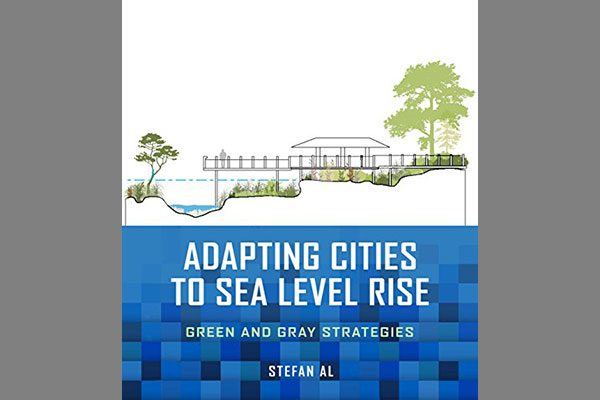
Author: Stefan Al (Island Press, 2018)
Many of our world’s urban centres lie along the shores of oceans and seas. As areas of rapid urbanization, critically understanding strategies that minimize the negative impacts of sea level rise on coastal cities, and the lives contained within them, are of increasing importance. More so, given that the effects of rising seas extend well beyond the potential damage associated directly with settlements to include other significant issues such as natural habitat loss, land erosion, and the contamination of agricultural land. In light of this, Stefan Al—author of a number of well-received books such as The Strip and Villages in the City—has turned his gaze towards collecting and succinctly describing a diversity of water management strategies for coastal urban environments in Adapting Cities to Sea Level Rise: Green and Gray Strategies.
Intended as a succinct, accessible reference of shoreline design responses to sea level rise, the book does well to provide an easy-to-read toolbox of shoreline intervention types—building the case for creating more ‘resilient’ cities through using an integrated approach to the challenges faced by coastal cities and rising water levels.
As outlined in Introduction of the book, Al defines ‘resilience’ as the “capacity of individuals, communities, institutions, business and systems within a city to survive, adapt, and grow no matter what kinds of chronic stresses and acute shocks they experience.” As such, he argues for design responses that “create new civic assets for cities” through integrated solutions that meaningfully engage the public realm, natural processes and local communities.
With this in mind, Al categorizes and describes ‘Green’ and ‘Gray’ flood management solutions—the latter being the traditional, civil engineering approach to flood protection while the former looks towards ‘softer’ ecological principles and natural processes. He further divides these two categories into four strategies—Hard Protect, Soft Protect, Store and Retreat—ultimately calling for a hybrid approach.
Building on Al’s legacy of well-illustrated books, the above is anchored by a graphic “toolbox” summary—composed of small, simple cross-section diagrams—of the 64 sea level rise design interventions that will be described later in the book.
The final pages of the Introduction are given to briefly describing the comprehensive resilience plans of four cities—Rotterdam, New York, New Orleans, and Ho Chi Minh City—that will be looked at in further detail in first Part of the book. It also highlights the need for collaborative design approaches in the face of the uncertain future ahead of us.
This transitions into Part 1: City Strategies that consists of four chapters: one dedicated to each of the case study cities outlined above. These are not in-depth outlines, however. Instead, they briefly summarize the unique challenges faced by each location with respect to flood protection and how they responded in kind. Overall, they expose readers to a variety of contexts and solutions.
The Introduction and Part 1: City Strategies account for roughly 40% of this compact 140 page book. The remainder, and arguably most significant part of Adapting Cities to Sea Level Rise, lies in Part 2: Local Strategies that consists of chapters dedicated to the four strategies to flood protection outlined in the Introduction—Hard Protect, Soft Protect, Store and Retreat—as well as a very brief two-paragraph Conclusion.
Each chapter focused on a single flood protection strategy is further divided into very specific design solutions that are succinctly described in terms of Performance, Pros, Cons, and Design Goals. Each is also accompanied by related cases studies, photographs and, of course, the clear graphics Al has become known for.
More specifically, Hard Protect Strategies is further divided into Protect + Reoccupy/Reclaim, Seawall, Revetment, Breakwater, Floodwall, Dike, Multipurpose Dike and Surge Barrier. On the other hand, Soft Protect Strategies, is separated into Living Shoreline, Dunes and Beach Nourishment, and Floating Island. Store Strategies is partitioned into Floodable Plain, Polder, Floodable Square, and Storm Infiltration, while Retreat Strategies consists of Raised Ground, Floodproofing, and Strategic Retreat.
This simple structure makes Adapting Cities to Sea Level Rise very easy to reference. In doing so, it also supports the hybrid approach advocated by the author, as one can comfortably find their way through the content—getting a quick overview of different strategies and responses—and select the best solutions to meet specific criteria. The compact frame of the book and clear visuals further add to its approachability.
Overall, Adapting Cities to Sea Level Rise is a strong entry point to the complex and important topic of flood protection. Its accessible tone and typological approach is sure to appeal to designers, architects, urban planners and others interested in shoreline design responses. One can only hope that Stefan Al’s plea to (re)designing shorelines with people and natural systems in mind is heard far and wide.
***
You can learn more about Adapting Cities to Sea Level Rise from the Island Press website. You can also learn more about Stefan Al and other books he has authored from on his website here.
**
Erick Villagomez is one of the founding editors at Spacing Vancouver and the author of The Laws of Settlements: 54 Laws Underlying Settlements across Scale and Culture. He is also an educator, independent researcher and designer with personal and professional interests in the urban landscapes. His private practice – Metis Design|Build – is an innovative practice dedicated to a collaborative and ecologically responsible approach to the design and construction of places. You can see more of his artwork on his Visual Thoughts Tumblr and follow him on his instagram account: @e_vill1.



